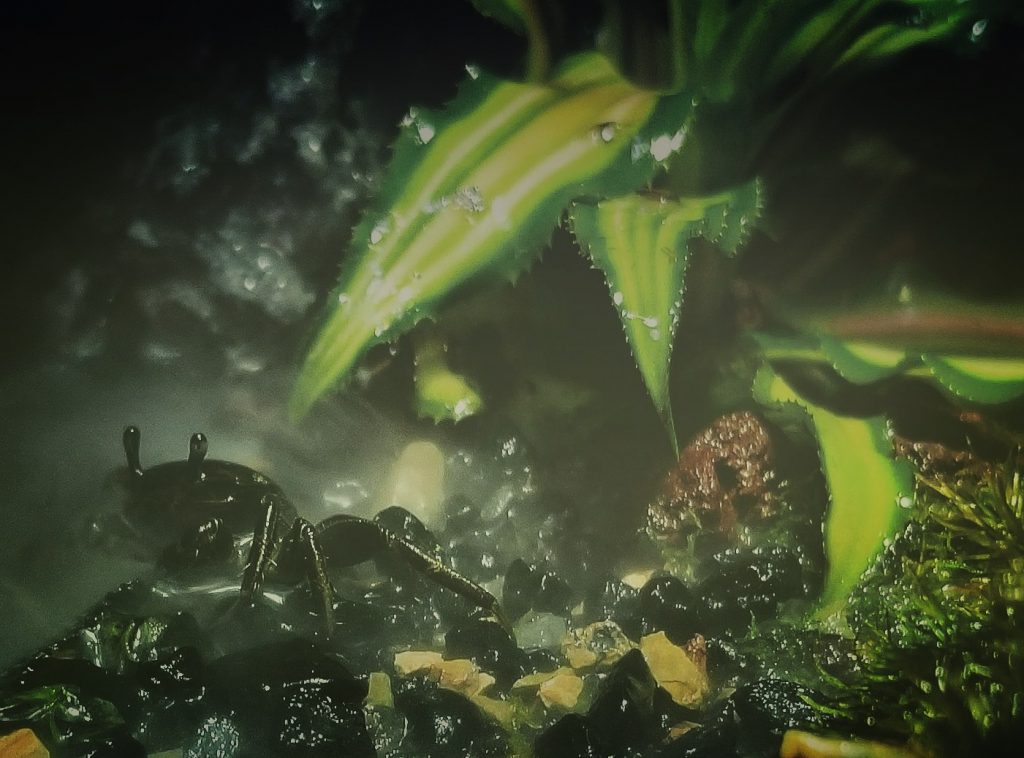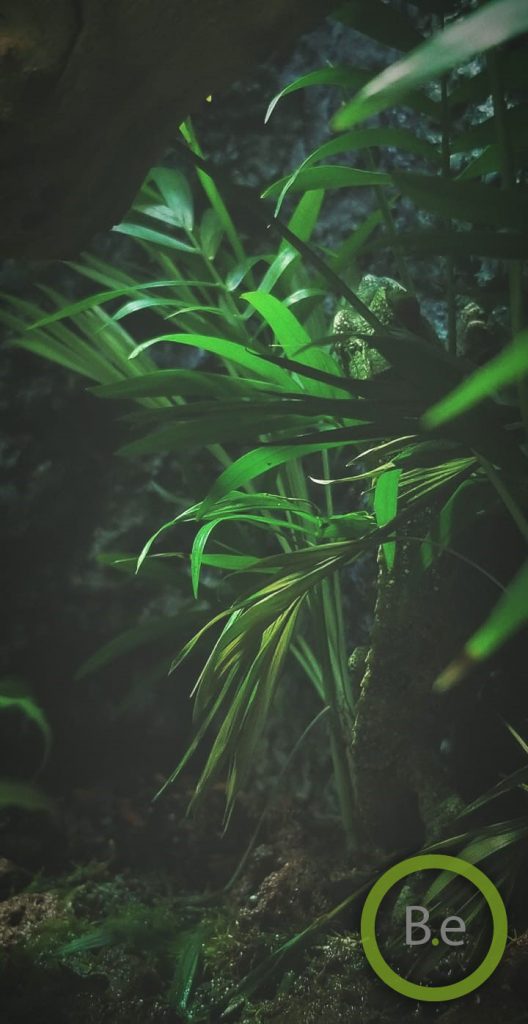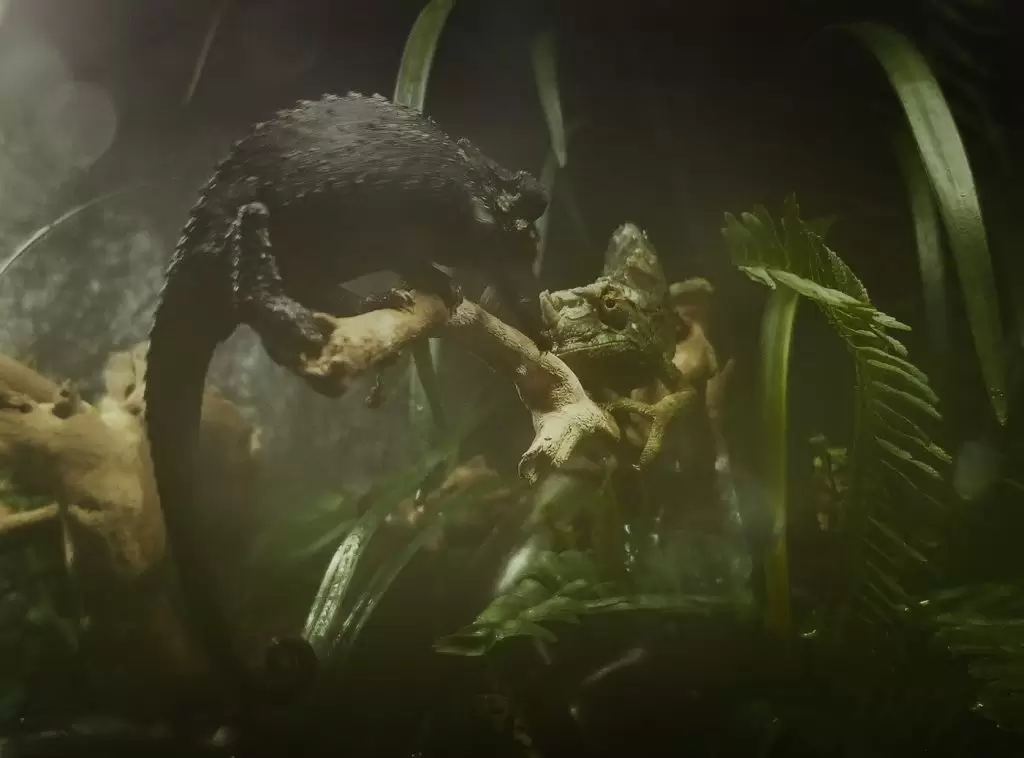I have to admit something.. Stocking Edens.Bow with paludarium animals and watching them thrive, has been one of the most entertaining things I’ve done in a while. In the last post, we scaped the paludarium with plants. At this point, we should be ready to introduce inhabitants to the tank.


Building A Multi-Species Paludarium
Before we start, it’s very important to note that we have to be very careful with what animals we put together. Some animals can be territorial towards other species and also towards the same sex within their species. Even if the paludarium is a predator-style enclosure, it should be a priority to keep the inhabitants as stress-free as possible to ensure a long healthy life.
Something else to note, try to choose paludarium animals that are fit to thrive in the paludarium’s environment. You obviously wouldn’t put a bearded dragon in this type of tropical enclosure.
Also quarantining new animals in a separate enclosure for two to three weeks is safe to practice as you go. Introducing an animal carrying a parasite can cause the whole ecosystem to collapse if you aren’t careful. Growing my feeder fish was something I begin to do once I understood the dangers of adding such poorly managed fish to my paludarium.


This list of paludarium animals prepared here is in no way a perfect list of animals. This is more based on my own experience and observation with animals I’ve successfully kept together. I will update this list frequently as I introduce new animals to this paludarium and document their experiences as they grow.
Good Clean-Up Crew Animals
This is an easy solution to keeping a paludarium cleaner that I’m shocked more enthusiasts don’t practice. Uneaten food and animal waste can quickly accumulate once a tank has animals living in it.
Another factor you will notice with a paludarium sooner or later… It is how much fungus and algae will thrive in the enclosure without something there to combat it. These are a few great choices of clean-up crew inhabitants stocked in Edens.Bow:


- Ghost Shrimp – As far as marine life, shrimp are some of the easiest crustaceans to acquire. They are cheap and if the water parameters are healthy, they will breed and thrive in the aquarium. They eat everything from uneaten food to algae, to even fish waste caught in the gravel. I keep these guys in the bottom portion of the paludarium as well as the sump to help break down waste for consumption for the healthy bacteria. https://amzn.to/2Abl2qV
- Fiddler Crab – These guys are my favorite to watch. Something about the way the males wave at me when I come close to the tank is so funny to me. The cool part about these guys is they’re Semi-aquatic… Meaning they will live on the land and water parts of the tank. Even though they spend most of their time on the land, the ideal aquarium should be somewhat brackish for them to thrive. Crabs will eat anything! From uneaten fish food, to live critters like crickets and mealworms bigger reptiles might miss. They seem mostly timid to me and will shy away from bigger paludarium inhabitants… Making them pretty safe to keep around reptiles like chameleons.
- Springtails – These guys are a must-have for any vivarium. They spend most of their time under moist substrate in the terrarium. They eat fungus and uneaten food mostly but I’ve noticed them breaking down reptile waste from time to time. If they end up in the aquarium for whatever reason, they will just make a nice treat to an alert fish. These guys should be at the top of your list as far as a clean-up crew animal.
- Isopods – As a kid, we used to call these rollie-pollies… I never would have known how beneficial these guys would be to the environment. These guys mostly thrive on dead plant leaves and roots. You won’t see them often as they like to stay buried in the substrate near moisture. A lot of people think of them as an insect but they are a species of crustaceans that can breathe underwater.
The Best Types Of Aquatic Paludarium Animals
It’s so easy to get carried away and overstock a paludarium with aquatic animals. I’ve experimented with a variety of fish in this aquarium. There are a few things to be conscious of when adding aquatic life… Make sure they like a similar range of Ph and temperature. If it’s a community tank, make sure none of the fish are territorial towards other fish.


If you haven’t already, cycle the tank! You must have some type of healthy bacteria circulating in the tank before you can sustain healthy aquatic life. One way to do this is by adding bits of fish food to the aquarium and adding bottled bacteria manually to stimulate the growth of bacteria in the tank. You could add fish in a matter of days going that route.
- Mollies – These guys are pure warriors! In my experience, they are some of the hardiest fish on the market. They come in a variety of colors and can survive in all types of water parameters. These are one of the only fish that are found in freshwater as well as saltwater. On top of all that, they breed easily… Making them ideal candidates for feeder fish. I highly suggest starting your new tank with mollies for the simple fact that they will have the highest success rate in a newly established tank… Which will aid in jump-starting the paludarium. https://amzn.to/2JXnFfp
- Guppies – Another highly hardy fish that breed well. These guys come in some of the most beautiful colors and do well with other fish. Guppies are second to the list when it comes to establishing a new aquarium. https://amzn.to/2uSyGtK
- Angel Fish – Once your freshwater paludarium is a bit more established, I’d recommend angelfish. They are fun and very interactive fish to keep in your collection. They can grow pretty big over time and do well on any type of food. Be cautious about keeping smaller fish around them. They will try and feed on anything big enough to fit in their mouth. https://amzn.to/2uOqcny
- Catfish – Coming from the rural parts of Virginia, I’ve always enjoyed the company of catfish. They are mostly bottom-dwelling fish but will come up for food. These guys are pretty nocturnal, so they keep the tank “alive” at all times of the night. These guys are exceptional at keeping the tank clean since they eat any uneaten food and dead animals they run across. https://amzn.to/2JVFz29
- Sharks – Anyone looking to give a community tank a “predator” look without the predator, should consider Bala sharks or Iridescent Sharks. Bala sharks are very easy to care for like most scale-bearing fish… But Iridescent Sharks can be a bit more difficult. These guys require a bit more understanding and are very easily prone to diseases like Ick.. both fish can get extremely big if managed properly, long enough. https://amzn.to/2uP3FXI
- Arowana – These have become extremely popular lately.. and for good reason! They are extremely beautiful fish and can grow as big as two feet in length. Arowanas are pretty peaceful fish when kept with fish similar in size. They spend almost all of their time at the top of the aquarium. Arowanas eat a variety of foods, both live and prepared. I wouldn’t rank these fish as hard to care for but I would suggest having a well-established aquarium with healthy water conditions. https://amzn.to/2uRYGFz
- African Butterfly Fish – These guys are a lot like Arowana’s except they don’t grow that big. The average adult reaches 5 to 7 inches. I really enjoy watching these guys catch crickets that fall into the aquarium. They seemed to be good community fish as they don’t really pay other fish any mind. The coolest feature these guys have is their fins. They have what look like actual butterfly wings for side fins… I haven’t witnessed mine taking flight yet, but do keep a lid or around the topwater part… They are known to jump out chasing bugs!
- Freshwater Barracuda – If you are aiming to have more of a predator-type of enclosure, any type of gar or pike will be a good addition. The freshwater barracuda, also known as a rocket gar, is the smallest in the pike family. As a baby, this was an exciting addition to Edens.Bow… It didn’t take long to realize I might have underestimated the growth rate of a predator fish like this guy. After a couple of weeks of wiping out almost the entire livestock of this paludarium, I decided it would be more enjoyable maintaining Edens.Bow as a community tank. The Barracuda now enjoys his very own enclosure all to itself, where he can live stress-free!
The Best Types Of Non-aquatic Paludarium Animals
This is a very fun feature of the paludarium that does require patience and safety. Reptiles and amphibians are the obvious choices when choosing an animal to live in the terrarium part of the enclosure. You MUST be mindful that not all of them can swim! When choosing to stock our paludarium with chameleons… We were very careful to net the open portions of the aquarium to prevent non-aquatic animals from falling in. The same precautions should be taken for paludarium animals that cannot survive in water deeper than their height.
Another important thing to note! From my experience and latest observation, most reptiles and some amphibians prefer solitaire and can pass parasites off to each other when mixing multiple species within the same setup. My advice would be to take a moment to consider one main terrestrial species and make sure they can tolerate more than one of their own kind before stocking your tank with a particular reptile or amphibian…


- Jackson Chameleon – This was my whole intention when I began this project. I absolutely love chameleons and wanted to create something as close to their native habitat as possible. As babies, we were able to keep a male & female pair together in the same enclosure. Once they reach sexual maturity, they started to become a bit of a nuisance lol. When deciding who to leave in the tank, I decided the female was a bit less destructive to the environment and she got to earn the title “Queen of Edens.Bow”!
- Tree frogs – These guys, as well as glass frogs and dart frogs, are also great candidates for a paludarium. They like high humidity as well as plants that hold water well like bromeliads. These guys are fun to watch and come in a variety of beautiful colors. I have only kept tadpoles in the pond section of our terrarium and still debating if Edens.Bow will be a home for any type of frog species.
- Eastern Worm Snake – I don’t have much experience with snakes in a paludarium but I do think at some point I will consider a paludarium exclusively for one. If one would be considered for Edens.Bow, it would more than likely be something small like an eastern worm snake. Again, if I would add one it would more than likely be the only reptile in this paludarium.
When it comes to reptiles, if not semi-aquatic, it is best to keep only one by itself… Preferably one that likes to spend most of its time high up in the canopy like a chameleon. Hints at why I chose that over a snake or lizard. Even with frogs, you have to be careful the babies aren’t mistaken for food for reptiles and that they can swim!


The Best Types Of Semiaquatic Paludarium Animals
Now for the real secret to my success with having a fully multi-species paludarium! Semi-aquatic animals are some of the most interesting types of paludarium animals. Watching them take full advantage of a paludarium is so satisfying to watch. They organize the habitat in such cool ways… A place to eat, a place to dry off and bask…


- Yellow-Bellied Slider – Turtles can pack a ton of personality! As babies, these guys will spend most of their time keeping to themselves. As they grow they will get more comfortable with tank mates and even steal food when they can. They love insects but become more of a vegetarian as they get older. These guys can be a bit destructive in the tank when it comes to pulling up plants. They will even dig holes in the substrate to find a comfy sleeping spot at night.
- Fiddler Crab – we have already covered these guys but I will add them here since they deserve more credit than just a cleanup crew. Fiddler crab might just be my favorite species within Edens.Bow!
- Water Dragons – I have considered adding these guys to the paludarium for a while. I think I won’t since the chameleon is already inhabiting the top for now. But I am very interested in these guys since they went require the open water part to be covered with a net.
- Skink Lizards – There are too many types of these guys to name them. I think if I had to consider one it more than likely be the crocodile skink. These guys keep to themselves and are very cool to watch hunt for guppies at night. My biggest caution with these guys is making sure that they can easily get in and out of the water.
- Iguana – The downside to these guys is they can get really big.. like potentially 7 feet big! But you could keep a baby in a paludarium for up to a year. These guys also come with individual personalities and can be a bit territorial. They eat on plants so if keeping a stunning plant scape is the priority, an iguana might not be best for you.
- Mud-skippers – This will more than likely be the next addition to the Edens.Bow family. I think the bizarre flare of a land-walking fish is such a cool feature to have in a paludarium. I will tell you guys more as I gain experience with one!
Conclusion
So with that being said, we have finally come to the conclusion for BEHINDtheBUILD with Edens.Bow. I hope you found this series both insightful and inspiring! I’m looking forward to seeing all the potential ideas that spring out of this build. I hope you keep me informed as you progress!


